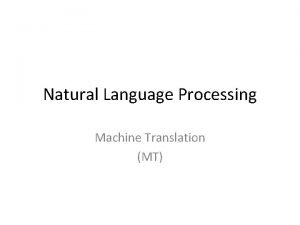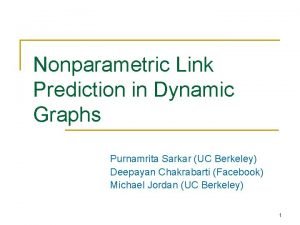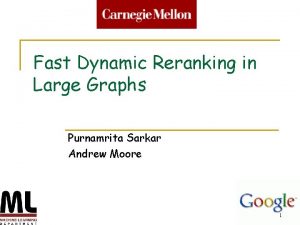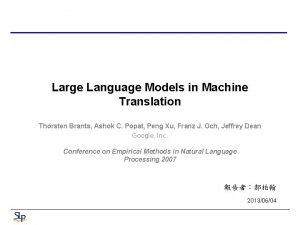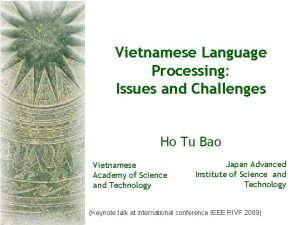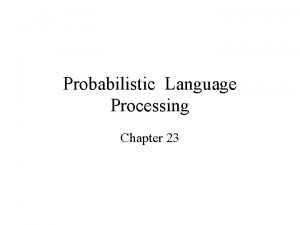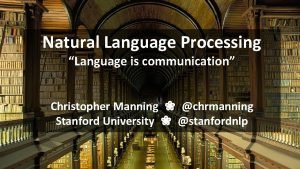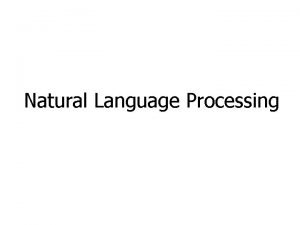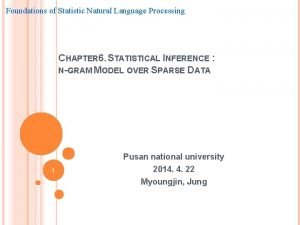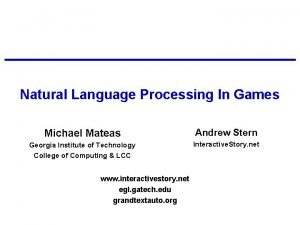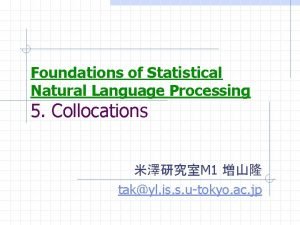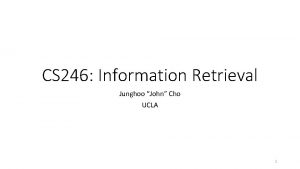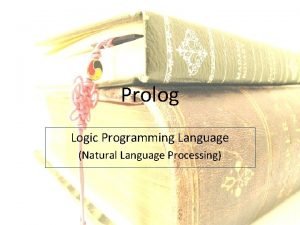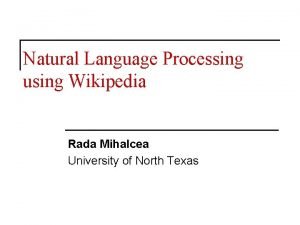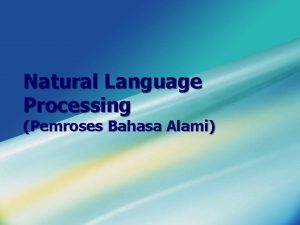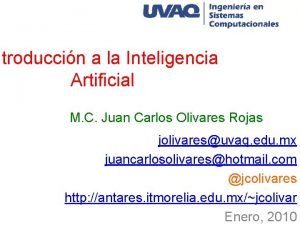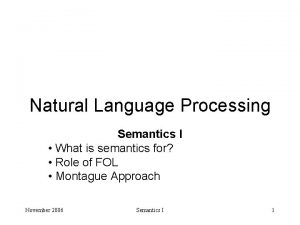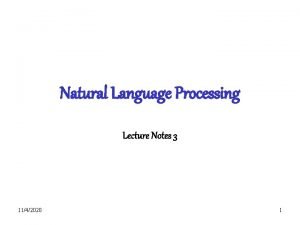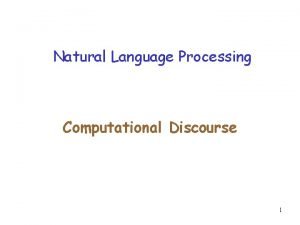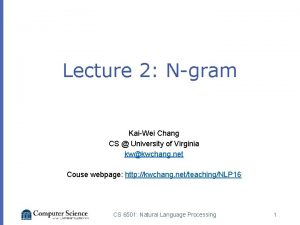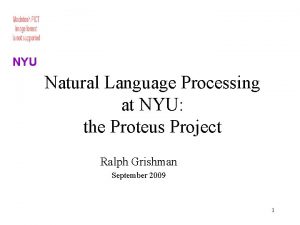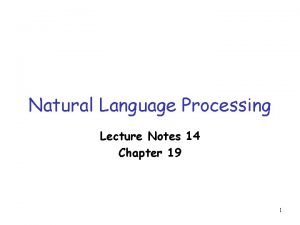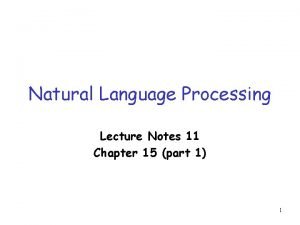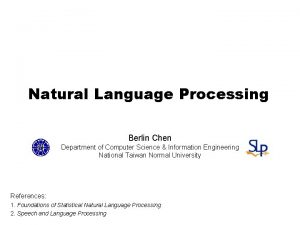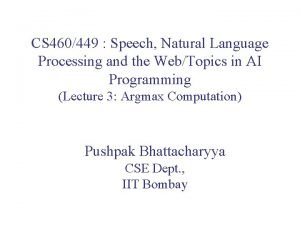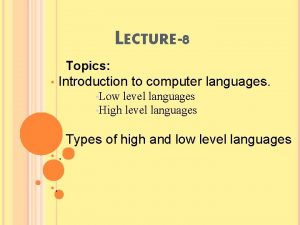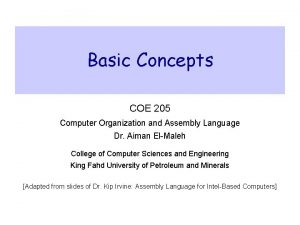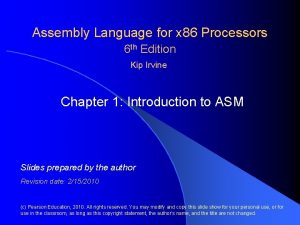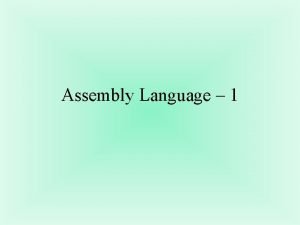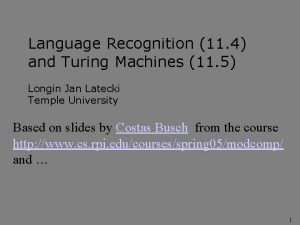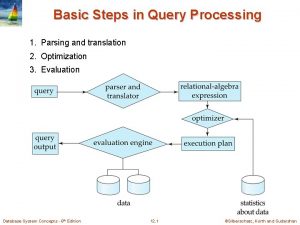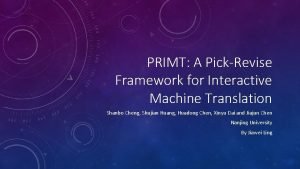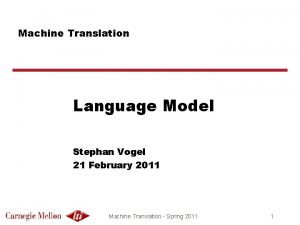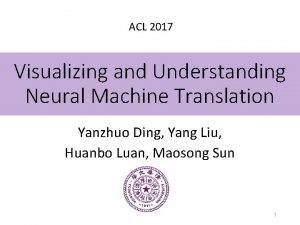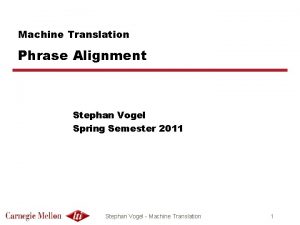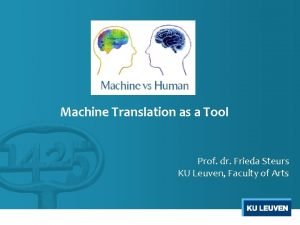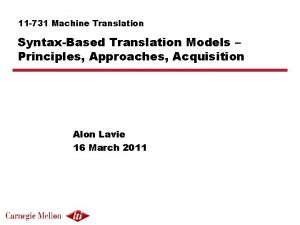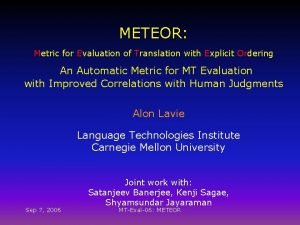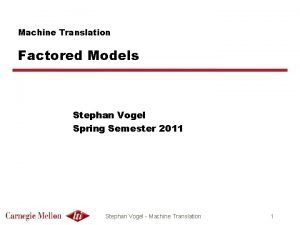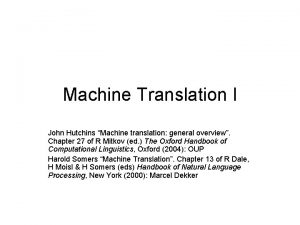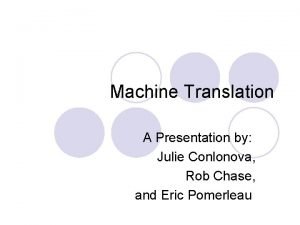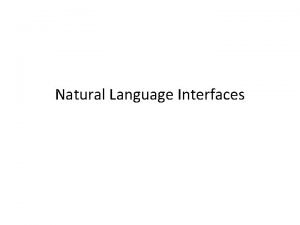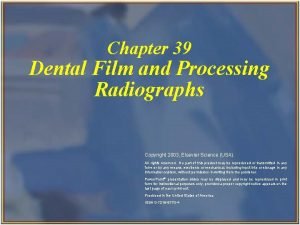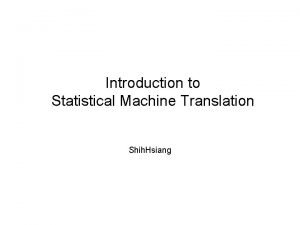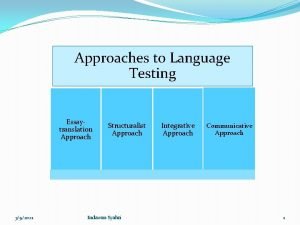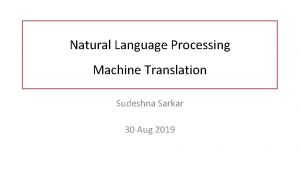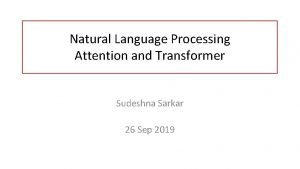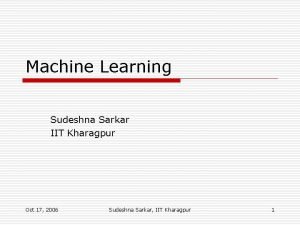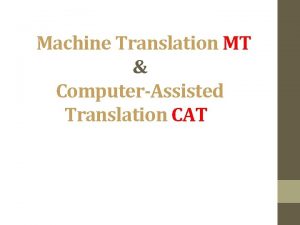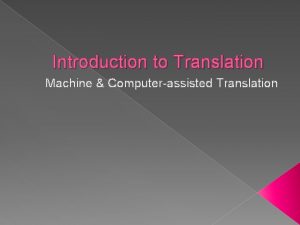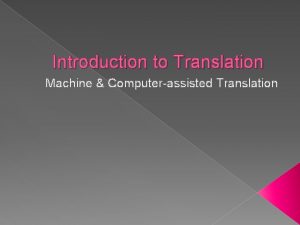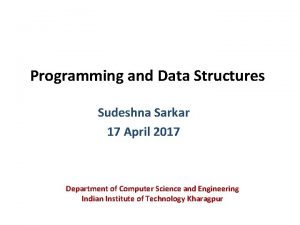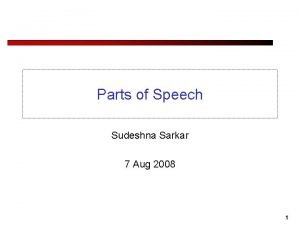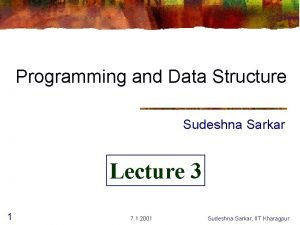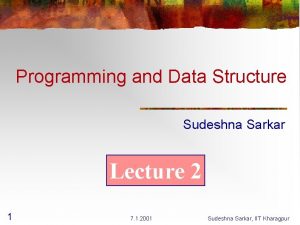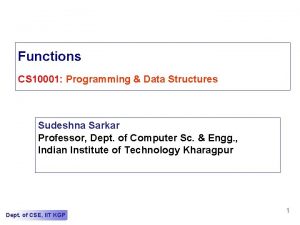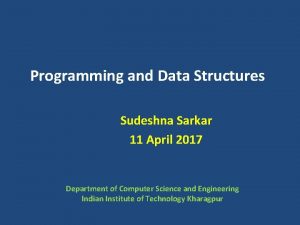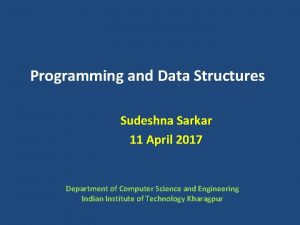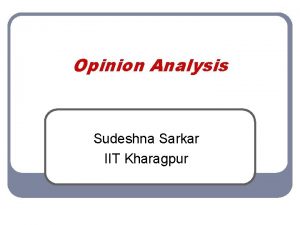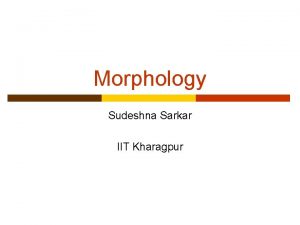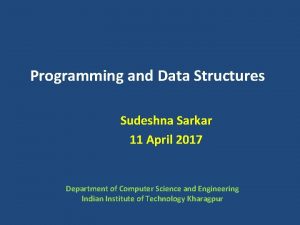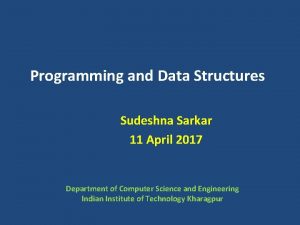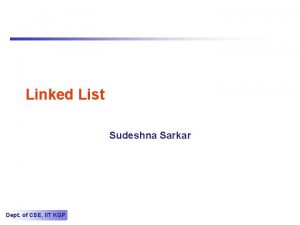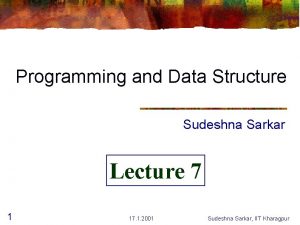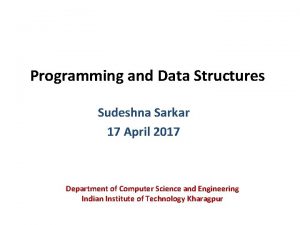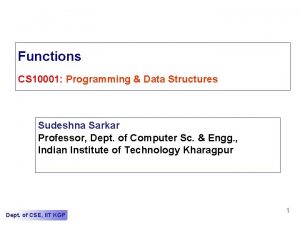Natural Language Processing Machine Translation Sudeshna Sarkar 4





























![Training Algorithm Initialize all t(f|e) to any value in [0, 1]. Repeat the E-step Training Algorithm Initialize all t(f|e) to any value in [0, 1]. Repeat the E-step](https://slidetodoc.com/presentation_image_h2/0e1f530232ab1f4e17aaa2e1305a692a/image-30.jpg)





















































- Slides: 83

Natural Language Processing Machine Translation Sudeshna Sarkar 4 Sep 2019

Vauquois Triangle

Direct Transfer • Morphological Analysis – Mary didn’t slap the green witch. → Mary DO: PAST not slap the green witch. • Lexical Transfer – Mary DO: PAST not slap the green witch. – Maria no dar: PAST una bofetada a la verde bruja. • Lexical Reordering – Maria no dar: PAST una bofetada a la bruja verde. • Morphological generation – Maria no dió una bofetada a la bruja verde. 3

Syntactic Transfer • Simple lexical reordering does not adequately handle more dramatic reordering such as that required to translate from an SVO to an SOV language. • Need syntactic transfer rules that map parse tree for one language into one for another. – English to Spanish: • NP → Adj Nom NP → Nom ADJ – English to Japanese: • VP → V NP VP → NP V • PP → P NP PP → NP P 4

Semantic Transfer • Some transfer requires semantic information. • Semantic roles can determine how to properly express information in another language. • In Chinese, PPs that express a goal, destination, or benefactor occur before the verb but those expressing a recipient occur after the verb. • Transfer Rule – English to Chinese • VP → V PP[+benefactor] VP → PP[+benefactor] V 5

Statistical MT • Manually encoding comprehensive bilingual lexicons and transfer rules is difficult. • SMT acquires knowledge needed for translation from a parallel corpus or bitext that contains the same set of documents in two languages. • First align the sentences in the corpus based on simple methods that use coarse cues like sentence length to give bilingual sentence pairs. 6

Picking a Good Translation • 7

Noisy Channel Model • Based on analogy to information-theoretic model used to decode messages transmitted via a communication channel that adds errors. • Assume that source sentence was generated by a “noisy” transformation of some target language sentence and then use Bayesian analysis to recover the most likely target sentence that generated it. Translate foreign language sentence F=f 1, f 2, …fm to an English sentence Ȇ = e 1, e 2, …e. I that maximizes P(E | F) e Noisy Channel f • Task is to recover e from noisy f. • P(F|E): Translation model • P(E): Language model 8

Bayesian Analysis of Noisy Channel A decoder determines the most probable translation Ȇ given F Translation Model Source Eng P(Eng) Language model Transmitter (encoder) Language Model Noisy Channel P(Fre|Eng) Translation model Receiver Destination (decoder) Fre Eng’ P(Eng’|Fre)=? Observation Guessed input 9

Language Model • Use a standard n-gram language model for P(E) or. . • Can be trained on a large, unsupervised mono-lingual corpus for the target language E. 10

Statistical machine translation

IBM translation models • A generative model based on noisy channel framework – Generate the translation sentence e with regard to the given sentence f by a stochastic process 1. Generate the length of f 2. Generate the alignment of e to the target sentence f 3. Generate the words of f –

Word Alignment • Directly constructing phrase alignments is difficult, so rely on first constructing word alignments. • Can learn to align from supervised word alignments, but human-aligned bitexts are rare and expensive to construct. • Typically use an unsupervised EM-based approach to compute a word alignment from unannotated parallel corpus. 13

Word alignment • One to one, one to many and reordering John told Mary a Jean a raconté Jean John Source sentence told Mary a story. une histoire raconté une à Marie. histoire à Target sentence Marie

Word alignment • Many to one and missing word John swam across the lake. Target sentence Jean a traversé le lac à la nage. A special symbol Jean a traversé le lac à la nage NULL John Source sentence swam across the lake CS@UVa CS 6501: Text Mining 15

Representing word alignments • Alignment table 0 NULL 1 John 2 swam 3 across 4 the 5 lake 1 2 3 4 5 6 7 8 Jean a traversé le lac à la nage Target Position 1 2 3 4 5 6 7 8 Source Position 1 3 3 4 5 0 0 2

One to Many Alignment • To simplify the problem, typically assume each word in F aligns to 1 word in E (but assume each word in E may generate more than one word in F). • Some words in F may be generated by the NULL element of E. • Therefore, alignment can be specified by a vector A giving, for each word in F, the index of the word in E which generated it. 17

IBM Model 1 • First model proposed in seminal paper by Brown et al. in 1993 as part of CANDIDE, the first complete SMT system. • Assumes following simple generative model of producing F from E=e 1, e 2, …e. I – Choose length, J, of F sentence: F=f 1, f 2, …f. J – Choose a 1 to many alignment A=a 1, a 2, …a. J – For each position in F, generate a word fj from the aligned word in E: e aj 18

IBM translation models • Length of target sentence f

IBM translation models • Sequence of 5 translation models – Different assumptions and realization of the components in the translation models, i. e. , length model, alignment model and translation model – Model 1 is the simplest and becomes the basis of follow-up IBM translation models

Parameters in Model 1 • length of source sentence

Parameters in Model 1 • We add a NULL word in the source sentence

Recap: IBM translation models • Length of target sentence f

Generative process in Model 1 Source Alignment Encoded 1 2 3 4 5 NULL John swam across the lake 1 2 3 4 5 6 7 8 ? ? Target Position 1 2 3 4 5 6 7 8 Source Position 1 3 3 4 5 0 0 2 Order of action Transmitter English 0 John across the lake NULL swam 1 3 3 4 5 0 0 2 Jean a traversé le lac à la nage

Decoding process in Model 1 Encoded 2 3 4 5 NULL John flies across the river 1 2 3 4 5 6 7 8 ? ? Search through all English sentences Search through all possible alignments Target Position 1 2 3 4 5 6 7 8 Source Position 1 2 4 5 5 2 0 3 John flies the river flies NULL across 1 2 4 5 5 2 0 3 Jean a traversé le lac à la nage Receiver Alignment 1 Order of action English 0

Decoding process in Model 1 Encoded 2 3 4 5 NULL John swam across the lake 1 2 3 4 5 6 7 8 ? ? Search through all English sentences Search through all possible alignments Target Position 1 2 3 4 5 6 7 8 Source Position 1 3 3 4 5 0 0 2 John across the lake NULL swam 1 3 3 4 5 0 0 2 Jean a traversé le lac à la nage Receiver Alignment 1 Order of action English 0

Decoding process in Model 1 • Search space is huge – Presumably all “sentences” in English • English sentence length is unknown • All permutation of words in the vocabulary – Heuristics to reduce search space • Trade-off between translation accuracy and efficiency

Alignments • The generative process explains only one way of generating a sentence pair – Each way corresponds to an alignment • Total probability of the sentence pair is the sum of probability over all alignments • Input: Parallel sentences 1…S in languages E and F • But alignments are not known • Goal: Learn the model P(f|e)

Estimation of translation probability • If we do not have ground-truth word-alignments, appeal to Expectation Maximization algorithm – Intuitively, guess the alignment based on the current translation probability first; and then update the translation probability
![Training Algorithm Initialize all tfe to any value in 0 1 Repeat the Estep Training Algorithm Initialize all t(f|e) to any value in [0, 1]. Repeat the E-step](https://slidetodoc.com/presentation_image_h2/0e1f530232ab1f4e17aaa2e1305a692a/image-30.jpg)
Training Algorithm Initialize all t(f|e) to any value in [0, 1]. Repeat the E-step and M-step till t(f|e) values converge E-Step • for each sentence in training corpus – for each f, e pair : Compute c(f|e; f(s), e(s)) – Use t(f|e) values from previous iteration M-Step c(f|e) is the expected count that f and e are aligned • for each f, e pair: compute t(f|e) • Use the c(f|e) values computed in Estep

Other translation models • IBM models 2 -5 are more complex – Word order and string position of the aligned words – Phase-based translation in the source and target languages • Incorporate syntax or quasi-syntactic structures • Greatly reduce search space

What you should know • Challenges in machine translation – Lexicon/syntactic/semantic divergences • Statistical machine translation – Source-channel framework for statistical machine translation • Generative process – IBM model 1 • Idea of word alignment

Sample IBM Model 1 Generation 0 NULL 1 2 3 4 5 6 Mary didn’t slap the green witch. Maria 1 no dió una bofetada 2 3 3 3 0 4 6 a la bruja 5 verde. 33

Computing P(F | E) in IBM Model 1 • Assume some length distribution P(J | E) • Assume all alignments are equally likely. Since there are (I + 1)J possible alignments: • Assume t(fx, ey) is the probability of translating ey as fx, therefore: • Determine P(F | E) by summing over all alignments: 34

Decoding for IBM Model 1 • Goal is to find the most probable alignment given a parameterized model. Since translation choice for each position j is independent, the product is maximized by maximizing each term: 35

HMM-Based Word Alignment • IBM Model 1 assumes all alignments are equally likely and does not take into account locality: – If two words appear together in one language, then their translations are likely to appear together in the result in the other language. • An alternative model of word alignment based on an HMM model does account for locality by making longer jumps in switching from translating one word to another less likely.

HMM Model • Assumes the hidden state is the specific word occurrence ei in E currently being translated (i. e. there are I states, one for each word in E). • Assumes the observations from these hidden states are the possible translations fj of ei. • Generation of F from E then consists of moving to the initial E word to be translated, generating a translation, moving to the next word to be translated, and so on.

Sample HMM Generation 1 2 3 4 5 6 Mary didn’t slap the green witch. Maria

Sample HMM Generation 1 2 3 4 5 6 Mary didn’t slap the green witch. Maria no

Sample HMM Generation 1 2 3 4 5 6 Mary didn’t slap the green witch. Maria no dió

Sample HMM Generation 1 2 3 4 5 6 Mary didn’t slap the green witch. Maria no dió una

Sample HMM Generation 1 2 3 4 5 6 Mary didn’t slap the green witch. Maria no dió una bofetada

Sample HMM Generation 1 2 3 4 5 6 Mary didn’t slap the green witch. Maria no dió una bofetada a

Sample HMM Generation 1 2 3 4 5 6 Mary didn’t slap the green witch. Maria no dió una bofetada a la

Sample HMM Generation 1 2 3 4 5 6 Mary didn’t slap the green witch. Maria no dió una bofetada a la bruja

Sample HMM Generation 1 2 3 4 5 6 Mary didn’t slap the green witch. Maria no dió una bofetada a la bruja verde.

Sample HMM Generation 1 2 3 4 5 6 Mary didn’t slap the green witch. Maria no dió una bofetada a la bruja verde.

HMM Parameters • Transition and observation parameters of states for HMMs for all possible source sentences are “tied” to reduce the number of free parameters that have to be estimated. • Observation probabilities: bj(fi)=P(fi | ej) the same for all states representing an occurrence of the same English word. • State transition probabilities: aij = s(j i) the same for all transitions that involve the same jump width (and direction).

Computing P(F | E) in the HMM Model • Given the observation and state-transition probabilities, P(F | E) (observation likelihood) can be computed using the standard forward algorithm for HMMs. 49

Decoding for the HMM Model • Use the standard Viterbi algorithm to efficiently compute the most likely alignment (i. e. most likely state sequence). 50

Training Word Alignment Models • Both the IBM model 1 and HMM model can be trained on a parallel corpus to set the required parameters. • For supervised (hand-aligned) training data, parameters can be estimated directly using frequency counts. • For unsupervised training data, EM can be used to estimate parameters, e. g. Baum-Welch for the HMM model.

Sketch of EM Algorithm for Word Alignment Randomly set model parameters. (making sure they represent legal distributions) Until converge (i. e. parameters no longer change) do: E Step: Compute the probability of all possible alignments of the training data using the current model. M Step: Use these alignment probability estimates to re-estimate values for all of the parameters. Note: Use dynamic programming (as in Baum-Welch) to avoid explicitly enumerating all possible alignments 52

Sample EM Trace for Alignment (IBM Model 1 with no NULL Generation) Training Corpus Translation Probabilities Compute Alignment Probabilities P(A, F | E) Normalize to get P(A | F, E) the house la casa green house casa verde green verde 1/3 house 1/3 1/3 the 1/3 1/3 green house casa verde 1/3 X 1/3 = 1/9 casa 1/3 la green house casa verde 1/3 X 1/3 = 1/9 1/3 Assume uniform initial probabilities the house la casa 1/3 X 1/3 = 1/9

Example cont. green house casa verde 1/2 Compute weighted translation counts green house casa verde 1/2 green verde 1/2 house 1/2 + 1/2 0 1/2 the verde Normalize rows to sum to one to estimate P(f | e) the house la casa 1/2 casa la 0 la green 1/2 0 house 1/4 1/2 1/4 0 1/2 the house la casa 1/2

Example cont. verde Translation Probabilities la green 1/2 0 house 1/4 1/2 1/4 0 1/2 the Recompute Alignment Probabilities P(A, F | E) casa green house casa verde 1/2 X 1/4=1/8 green house casa verde 1/2 X 1/2=1/4 the house la casa 1/2 X 1/2=1/4 Normalize to get P(A | F, E) Continue EM iterations until translation parameters converge the house la casa 1/2 X 1/4=1/8

Decoding • Goal is to find a translation that maximizes the product of the translation and language models. • Cannot explicitly enumerate and test the combinatorial space of all possible translations. • The optimal decoding problem for all reasonable model’s (e. g. IBM model 1) is NP-complete. • Heuristically search the space of translations using A*, beamsearch, etc. to approximate the solution to this difficult optimization problem. 56

Evaluating MT • Human subjective evaluation is the best but is time-consuming and expensive. • Automated evaluation comparing the output to multiple human reference translations is cheaper and correlates with human judgements. 57

Human Evaluation of MT • Ask humans to estimate MT output on several dimensions. – Fluency: Is the result grammatical, understandable, and readable in the target language. – Fidelity: Does the result correctly convey the information in the original source language. • Adequacy: Human judgment on a fixed scale. – Bilingual judges given source and target language. – Monolingual judges given reference translation and MT result. • Informativeness: Monolingual judges must answer questions about the source sentence given only the MT translation (task-based evaluation). 58

Computer-Aided Translation Evaluation • Edit cost: Measure the number of changes that a human translator must make to correct the MT output. – Number of words changed – Amount of time taken to edit – Number of keystrokes needed to edit 59

Automatic Evaluation of MT • Collect one or more human reference translations of the source. • Compare MT output to these reference translations. • Score result based on similarity to the reference translations. – BLEU – NIST – TER – METEOR 60

BLEU • Determine number of n-grams of various sizes that the MT output shares with the reference translations. • Compute a modified precision measure of the n-grams in MT result. 61

BLEU Example Cand 1: Mary no slap the witch green Cand 2: Mary did not give a smack to a green witch. Ref 1: Mary did not slap the green witch. Ref 2: Mary did not smack the green witch. Ref 3: Mary did not hit a green sorceress. Cand 1 Unigram Precision: 5/6 62

BLEU Example Cand 1: Mary no slap the witch green. Cand 2: Mary did not give a smack to a green witch. Ref 1: Mary did not slap the green witch. Ref 2: Mary did not smack the green witch. Ref 3: Mary did not hit a green sorceress. Cand 1 Bigram Precision: 1/5 63

BLEU Example Cand 1: Mary no slap the witch green. Cand 2: Mary did not give a smack to a green witch. Ref 1: Mary did not slap the green witch. Ref 2: Mary did not smack the green witch. Ref 3: Mary did not hit a green sorceress. Clip match count of each n-gram to maximum count of the n-gram in any single reference translation Cand 2 Unigram Precision: 7/10 64

BLEU Example Cand 1: Mary no slap the witch green. Cand 2: Mary did not give a smack to a green witch. Ref 1: Mary did not slap the green witch. Ref 2: Mary did not smack the green witch. Ref 3: Mary did not hit a green sorceress. Cand 2 Bigram Precision: 4/9 65

Modified N-Gram Precision • Average n-gram precision over all n-grams up to size N (typically 4) using geometric mean. Cand 1: Cand 2: 66

Brevity Penalty • Not easy to compute recall to complement precision since there are multiple alternative gold-standard references and don’t need to match all of them. • Instead, use a penalty for translations that are shorter than the reference translations. • Define effective reference length, r, for each sentence as the length of the reference sentence with the largest number of n-gram matches. Let c be the candidate sentence length. 67

BLEU Score • Final BLEU Score: BLEU = BP p Cand 1: Mary no slap the witch green. Best Ref: Mary did not slap the green witch. Cand 2: Mary did not give a smack to a green witch. Best Ref: Mary did not smack the green witch. 68

BLEU Score Issues • BLEU has been shown to correlate with human evaluation when comparing outputs from different SMT systems. • However, it is does not correlate with human judgments when comparing SMT systems with manually developed MT (Systran) or MT with human translations. • Other MT evaluation metrics have been proposed that claim to overcome some of the limitations of BLEU. 69

Syntax-Based Statistical Machine Translation • Recent SMT methods have adopted a syntactic transfer approach. • Improved results demonstrated for translating between more distant language pairs, e. g. Chinese/English. 70

Synchronous Grammar • Multiple parse trees in a single derivation. • Used by (Chiang, 2005; Galley et al. , 2006). • Describes the hierarchical structures of a sentence and its translation, and also the correspondence between their subparts. 71

Synchronous Productions • Has two RHSs, one for each language. Chinese: English: X X 是甚麼 / What is X • 72

Syntax-Based MT Example Input: 俄亥俄州的首府是甚麼? • 73

Syntax-Based MT Example X X Input: 俄亥俄州的首府是甚麼? • 74

Syntax-Based MT Example X X X What is 是甚麼 Input: 俄亥俄州的首府是甚麼? X X X 是甚麼 / What is X • 75

Syntax-Based MT Example X X What is 是甚麼 X the capital 首府 Input: 俄亥俄州的首府是甚麼? X X X 首府 / the capital X • 76

Syntax-Based MT Example X X X What is 是甚麼 X the capital 首府 X of 的 Input: 俄亥俄州的首府是甚麼? X X 的 / of X • 77 X

Syntax-Based MT Example X X X What is 是甚麼 X the capital 首府 X of 的 X Ohio 俄亥俄州 Input: 俄亥俄州的首府是甚麼? X 俄亥俄州 / Ohio • 78

Syntax-Based MT Example X X X What is 是甚麼 X the capital 首府 X of 的 X Ohio 俄亥俄州 Output: What is the capital of Ohio? Input: 俄亥俄州的首府是甚麼? • 79

Synchronous Derivations and Translation Model • Need to make a probabilistic version of synchronous grammars to create a translation model for P(F | E). • Each synchronous production rule is given a weight λi that is used in a maximum-entropy (log linear) model. • Parameters are learned to maximize the conditional loglikelihood of the training data. 80

Neural Machine Translation (NMT) • Encoder/Decoder framework maps sentence in source language to a "deep vector" then another LSTM maps this vector to a sentence in the target language F 1, F 2, …, Fn Encoder LSTM hn Decoder LSTM E 1, E 2, …, Em • Train model "end to end" on sentence-aligned parallel corpus. 81

NMT with Language Model • Vanilla LSTM approach does not use a language model so does not exploit monolingual data for the target language. • Can integrate an LSTM language model using “deep fusion. ” • Decoder predicts the next word from a concatenation of the hidden states of both the translation and language LSTM models. Softmax Concatenate TM TM 82

Conclusions • MT methods can usefully exploit various amounts of syntactic and semantic processing along the Vauquois triangle. • Statistical MT methods can automatically learn a translation system from a parallel corpus. • Typically use a noisy-channel model to exploit both a bilingual translation model and a monolingual language model. • Neural LSTM methods are currently the state-of-the-art. 83
 Machine translation in natural language processing
Machine translation in natural language processing Sudeshna banerjee
Sudeshna banerjee Taher haveliwala
Taher haveliwala High speed pcb material
High speed pcb material Definition of singleton set
Definition of singleton set Purnamrita sarkar
Purnamrita sarkar Dr anirban sarkar
Dr anirban sarkar Purnamrita sarkar
Purnamrita sarkar Purnamrita sarkar
Purnamrita sarkar Large language models in machine translation
Large language models in machine translation Natural language processing vietnamese
Natural language processing vietnamese Probabilistic model natural language processing
Probabilistic model natural language processing Natural language processing nlp - theory lecture
Natural language processing nlp - theory lecture Markov chain nlp
Markov chain nlp Christopher manning stanford
Christopher manning stanford Pengertian natural language processing
Pengertian natural language processing Discourse analysis nlp
Discourse analysis nlp Natural language processing lecture notes
Natural language processing lecture notes Language
Language Natural language processing fields
Natural language processing fields Statistical natural language processing
Statistical natural language processing Natural language processing nlp - theory lecture
Natural language processing nlp - theory lecture Natural language processing games
Natural language processing games Collocation nlp
Collocation nlp Ucla natural language processing
Ucla natural language processing History of prolog
History of prolog Rada mihalcea
Rada mihalcea Pengertian bahasa alami
Pengertian bahasa alami Natural language processing
Natural language processing Natural language processing
Natural language processing Logical form
Logical form Natural language processing lecture notes
Natural language processing lecture notes Reference phenomenon in nlp
Reference phenomenon in nlp Kaiwei chang
Kaiwei chang Adam meyers nyu
Adam meyers nyu Natural language processing lecture notes
Natural language processing lecture notes Natural language processing lecture notes
Natural language processing lecture notes Natural language processing berlin
Natural language processing berlin Dialogflow prebuilt agents
Dialogflow prebuilt agents Natural language processing
Natural language processing What is semantic translation?
What is semantic translation? Cisco voice translation rule
Cisco voice translation rule Vertical translation and horizontal translation
Vertical translation and horizontal translation Semantic translation và communicative translation
Semantic translation và communicative translation Low-level programming language
Low-level programming language Difference between assembly language and machine language
Difference between assembly language and machine language Difference between assembly language and machine language
Difference between assembly language and machine language Difference between assembly language and machine language
Difference between assembly language and machine language Turing machine
Turing machine Parsing and translation in query processing
Parsing and translation in query processing Interactive machine translation
Interactive machine translation Lms machine translation
Lms machine translation Visualizing and understanding neural machine translation
Visualizing and understanding neural machine translation Machine translation
Machine translation Machine translation
Machine translation Machine translation
Machine translation Machine translation
Machine translation Meteor metric
Meteor metric Lms machine translation
Lms machine translation John hutchins machine translation
John hutchins machine translation Machine translation presentation
Machine translation presentation Bottom-up processing example
Bottom-up processing example Bottom up processing vs top down processing
Bottom up processing vs top down processing Bottom up processing
Bottom up processing Neighborhood averaging in image processing
Neighborhood averaging in image processing Primary processing and secondary processing
Primary processing and secondary processing Image enhancement point processing techniques
Image enhancement point processing techniques Histogram processing in digital image processing
Histogram processing in digital image processing Parallel processing vs concurrent processing
Parallel processing vs concurrent processing Neighborhood processing in digital image processing
Neighborhood processing in digital image processing Point processing
Point processing Gonzalez
Gonzalez Top-down processing
Top-down processing What is interactive processing
What is interactive processing Natural langauge
Natural langauge What are the five steps in processing dental radiographs
What are the five steps in processing dental radiographs Natural hazards vs natural disasters
Natural hazards vs natural disasters Natural income
Natural income Finite state machine vending machine example
Finite state machine vending machine example Moore machine and mealy machine
Moore machine and mealy machine Moore machine
Moore machine Ma=fr/fe
Ma=fr/fe Spanish to english
Spanish to english Example of structuralist approach in language testing
Example of structuralist approach in language testing
